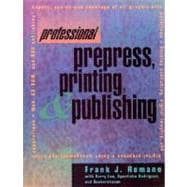
Professional Prepress, Printing, and Publishing
by Romano, FrankRent Book
New Book
We're Sorry
Sold Out
Used Book
We're Sorry
Sold Out
eBook
We're Sorry
Not Available
How Marketplace Works:
- This item is offered by an independent seller and not shipped from our warehouse
- Item details like edition and cover design may differ from our description; see seller's comments before ordering.
- Sellers much confirm and ship within two business days; otherwise, the order will be cancelled and refunded.
- Marketplace purchases cannot be returned to eCampus.com. Contact the seller directly for inquiries; if no response within two days, contact customer service.
- Additional shipping costs apply to Marketplace purchases. Review shipping costs at checkout.
Summary
A president of R.R. Donnelley once said "In a corner of a printing plant in Illinois, there stands a giant printing press that once ran night and day, producing sets of encyclopedias that would line the walls of American homes. Today, it stands silently. It will never run again on a regular basis."
Overnight, the preferred medium for encyclopedias switched from print to CD-ROM. People used to pay more than $2,000 for a printed set of encyclopedias. Now they can buy a CD-ROM encyclopedia for $40-or get it free with the purchase of almost any home computer.
The advantages over print are obvious. You can search and retrieve information faster and hyperlink to related subjects. There are pictures and sound and even video. With print, a high schooler would copy the text and in the process perhaps actually learn something. Today's cut and paste does not help a student at all. If fact, the encyclopedia is moving beyond the recorded disk. Britannica is on line. All 44 million words-and it is up to date. Multimedia gives you virtually unlimited access to information.
Multimedia or digital media or interactive media or electronic publishing or digital publishing - call it what you will - has changed the way in which we present and communicate information. Much of what I see is multi-mediocrity. But the potential is enormous. When it is good, it is mindboggling. When it is bad, it is the norm. We are still in the incunabula period of multimedia.
My world is publishing ink-on-paper products. Today printing companies maintain databases, printers stamp CD-ROMs, printers produce multimedia. And by the way, they also put ink on paper or board or plastic or foil. What then is a printer? What then is the printing industry? It does not only print books. There are also magazines and newspapers and journals and catalogs and direct mail and wallpaper and packaging. 80% of what printers print is because someone wants to sell something to someone else. And 70% of what it prints ultimately winds up in a landfill.
The pundits and consultants opine that print must die in order that electronic approaches must thrive. This may not be so. Digital media does absorb some volume of the material that might have made it into print. The Adobe web site is the equivalent of over 1 million pages. But much of it is programs and information that might not have made it into print in any case. Those who say print is dead do so in newsletters. The Wall Street Journal described printing as a "sunset industry" a while back. They had to say it in print as well.
The key is not to doggedly defend an indefensible position in paper publishing but to look at the entire publishing marketplace and search for an opportunity to change the rules. Book publishers often miss the market by printing too many copies or too few. The front-end costs of printing were so high that a publisher could not afford to print a few and come back later to print a few more if the demand warranted it. Only 2% of the 51,000 plus new book titles printed each year ever make it to a second printing. Like my books. 50% of the magazines you see at the newsstand are thrown away.
So my industry developed a concept for taking a publisher's content in digital form and using digital processes to print only as many copies as the publisher needed in the short term. It is called on-demand printing. No inventory. No warehouse. Just-in-time manufacturing. We use ink and toner and inkjet with conventional presses and new printers. There is no neutrality in the Digital Revolution. You must become a digital revolutionary.
So, welcome to the new world of prepress, printing and publishing.
Author Biography
Frank Romano is Melbert B. Cary Distinguished Professor of Graphic Arts at the Rochester Institute of Technology, a widely-respected consultant, and author of many best-selling graphics arts books, including PDF Printing and Workflow.
Table of Contents
2. Prepress and Preparation Basics.
3. Printing Processes.
4. Desktop Publishing.
5. The Mystery and Magic of Color.
6. Image Capture.
7. Finishing.
8. Workflow.
9. Publishing.
10. New Media.
11. Challenges.
12. Advanced Imaging.
13. Typography and Design.
14. The Future of Communications.
Index.
Excerpts
An electronic version of this book is available through VitalSource.
This book is viewable on PC, Mac, iPhone, iPad, iPod Touch, and most smartphones.
By purchasing, you will be able to view this book online, as well as download it, for the chosen number of days.
Digital License
You are licensing a digital product for a set duration. Durations are set forth in the product description, with "Lifetime" typically meaning five (5) years of online access and permanent download to a supported device. All licenses are non-transferable.
More details can be found here.
A downloadable version of this book is available through the eCampus Reader or compatible Adobe readers.
Applications are available on iOS, Android, PC, Mac, and Windows Mobile platforms.
Please view the compatibility matrix prior to purchase.
